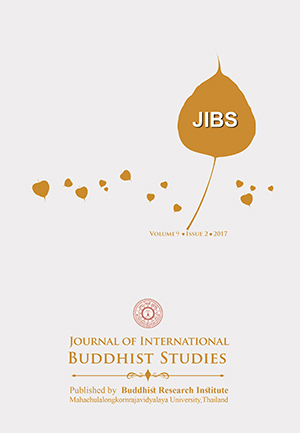A Thought Path model of Bodhisatta in Theravada Buddhism
Keywords:
Thought, Dharma perception, Mind Engagement, Thought model, BodhisattaAbstract
This article is dissertation part entitled “A Thought Path Model of Bodhisatta in Theravada Buddhism” has objectives to study the relationship of mind and mental products, thinking process and to build Thought Path model of Bodhisatta. Methodology is documentary research done by studying data in Tipiṭaka, Commentary and related academic works in Buddhism and science concerning mind. The research found that thought is expressed in behavior through bodily or verbal intimation by mechanism of material quality. By the thought, is caused and affected to Kamma clue, creating the round of rebirth transmigration. Bodhisatta Learning is based on trial and error, intellectual accumulating knowledge in Dharma perception through death and birth until adjusting corrected truth knowledge, in which thought path is mind engagement supporting perfections and vice versa. Core idea of the Bodhisatta consists in mind thinking state, virtue and factors state to promote the power of thought. Bodhisatta used “perfections acting” through feeling. Cultivation of perfection can change mind and Kamma structure given by mental charity and dwell object condition in preparing mind state readily with undertaking or advance attention on target of action.
References
Brabandere,L. D. (2007). Half forgot,Pray of imagination,Thought factory and Change’s origination. (Nutchaya Chaleaysub, Trans.). Bangkok: Millionaire PS Press.
Buddhaghosacariya.(2012). Visuddhimagga (complete Edition). Somdejpraputtajaan (VenerableArjArjsapa, Trans.) (10Ed). Bangkok: Thana Press.
______.(2017). Thai-commentary ofAbhidhammapiṭakaAttasalinee Mahachulalongkorn- rajavidyalaya Edition.Bangkok: Mahachulalongkornrajavidyalaya Press.
Cherkium Trungpa.(2000). The Legend of Freedom and the Way of the Prayer.(AnusornTipayanon, Trans.) Bangkok: Komol Kiemtong Foundation.
Mahachulalongkornrajavidyalaya University. (1996a). Thai-Tripitaka: DīghanikāyaPāthikavag-ga(Vol10) Mahachulalongkornrajavidyalaya Edition. Bangkok:Mahachulalongkorn-rajavidyalaya Press.
Mahachulalongkornrajavidyalaya University.(1996b). Thai-Tripitaka:SaṃyuttanikāyaNidāna-vagga(Vol16)Mahachula longkornrajavidyalaya Edition. Bangkok:Mahachulalongkornraja vidyalaya Press.
Mahachulalongkornrajavidyalaya University. (1996c). Thai-Tripitaka: AbhidhammapiṭakaDhammasaṅgaṇī(Vol33)Mahachulalongkorn rajavidyalaya Edition. Bangkok:Mahachulalongkornrajavidyalaya Press.
Nielsen, H. R. (2007). Confabulation theory the mechanism of Thought. NY: Springer-Verlag Berlin Heidelberg.
PhraDhammapitaka(P.A. Pyutto). (2008). Dictionary of Buddhism: Dharma Glossary Edition.(17Ed). Bangkok: Mahachulalongkornrajavidya laya Press.
PhraBranmagunabhorn (P.A. Pyutto). (2008). Dictionary of Buddhism: Vocab Glossary Edition.(11Ed). Bangkok: Junpenpublisher.
PhutPengpala. (1987). Analytical: Analysis of the Bodhisatta’s perfection Acts in Collection of Numerical Sayings (research report). Bangkok:Ramkhumheng University.
Thanet U., Kruefa K., Jittraporn T., &Nuchanart S. (2012).Electrical brainwave meterntype ALPHA.Biomedical Engineering Conference (BMECON 2012), (pp. 119-122). Phatumtani: Rangsituniversity.
Vinacke W. E., (1974). The Psychology of Thinking, (2nd ed). CA: Kingsport Press.
Watson, D. E., Williams B. O., (2003, January).Eccles' Model of the Self Controlling Its Brain: The Irrelevance of Dualist-Interactionism, NeuroQuantology. 1(1), 119-128. fromhttps://www.neuroquantol ogy.com/index.php/journal/article/view/8
WisitSripibul.(2009).The Lord of Time (2Ed). Bangkok: Bananasweet publisher,







